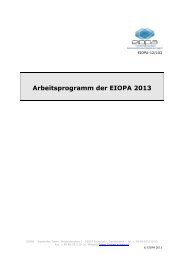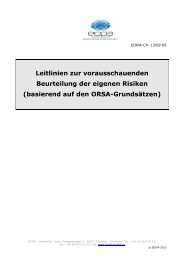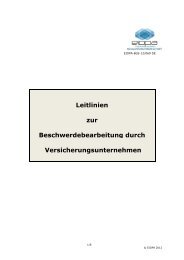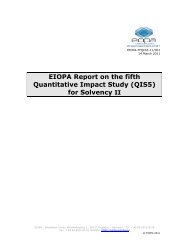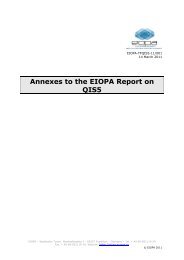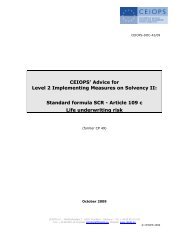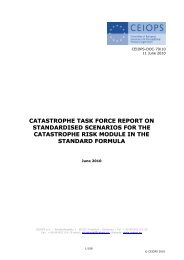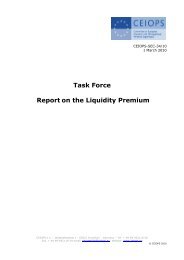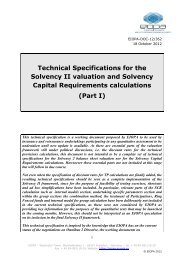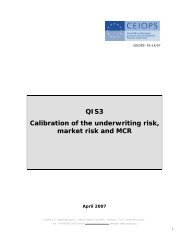Answers to the European Commission on the ... - Eiopa - Europa
Answers to the European Commission on the ... - Eiopa - Europa
Answers to the European Commission on the ... - Eiopa - Europa
Create successful ePaper yourself
Turn your PDF publications into a flip-book with our unique Google optimized e-Paper software.
B.95 In a scenario-based approach, <str<strong>on</strong>g>the</str<strong>on</strong>g> aim of <str<strong>on</strong>g>the</str<strong>on</strong>g> interest rate stress test is<br />
<str<strong>on</strong>g>to</str<strong>on</strong>g> establish <str<strong>on</strong>g>the</str<strong>on</strong>g> sensitivity of <str<strong>on</strong>g>the</str<strong>on</strong>g> surplus <str<strong>on</strong>g>to</str<strong>on</strong>g> movements in <str<strong>on</strong>g>the</str<strong>on</strong>g> term<br />
structure and <str<strong>on</strong>g>the</str<strong>on</strong>g> desired solvency for interest rate risk derived from it.<br />
The stress test <str<strong>on</strong>g>to</str<strong>on</strong>g> be computed relate <str<strong>on</strong>g>to</str<strong>on</strong>g> a general 'rise' and 'fall' in <str<strong>on</strong>g>the</str<strong>on</strong>g><br />
term structure of interest rates as used <str<strong>on</strong>g>to</str<strong>on</strong>g> discount <str<strong>on</strong>g>the</str<strong>on</strong>g> insurance<br />
liabilities.<br />
B.96 The value of <str<strong>on</strong>g>the</str<strong>on</strong>g> liabilities and investments is again determined<br />
comprehensively, assuming <str<strong>on</strong>g>the</str<strong>on</strong>g> prescribed higher or lower term<br />
structure of interest rates. The scenario with <str<strong>on</strong>g>the</str<strong>on</strong>g> largest loss has <str<strong>on</strong>g>to</str<strong>on</strong>g> be<br />
computed. This applies <str<strong>on</strong>g>to</str<strong>on</strong>g> both scenarios if it cannot be said with<br />
certainty in advance whe<str<strong>on</strong>g>the</str<strong>on</strong>g>r an interest rate increase or fall is <str<strong>on</strong>g>the</str<strong>on</strong>g><br />
more unfavourable for <str<strong>on</strong>g>the</str<strong>on</strong>g> financial positi<strong>on</strong> of <str<strong>on</strong>g>the</str<strong>on</strong>g> instituti<strong>on</strong>. The<br />
change in <str<strong>on</strong>g>the</str<strong>on</strong>g> surplus (difference between <str<strong>on</strong>g>the</str<strong>on</strong>g> value of <str<strong>on</strong>g>the</str<strong>on</strong>g> investments<br />
and <str<strong>on</strong>g>the</str<strong>on</strong>g> value of <str<strong>on</strong>g>the</str<strong>on</strong>g> liabilities) is established for each scenario. The<br />
greatest loss is included when determining <str<strong>on</strong>g>the</str<strong>on</strong>g> capital charge for<br />
interest rate risk.<br />
B.97 Yield curves movements (rising and falling) for <str<strong>on</strong>g>the</str<strong>on</strong>g> standard formula<br />
may be prescribed. Two aspects may have <str<strong>on</strong>g>to</str<strong>on</strong>g> be taken in<str<strong>on</strong>g>to</str<strong>on</strong>g> account in<br />
determining <str<strong>on</strong>g>the</str<strong>on</strong>g> stress tests. Firstly, <str<strong>on</strong>g>the</str<strong>on</strong>g> volatility in 'zero rates' for l<strong>on</strong>g<br />
periods is relatively less than for short periods. The higher <str<strong>on</strong>g>the</str<strong>on</strong>g> initial<br />
'zero rate', <str<strong>on</strong>g>the</str<strong>on</strong>g> larger <str<strong>on</strong>g>the</str<strong>on</strong>g> expected change. Both characteristics are<br />
comm<strong>on</strong>ly observed empirically.<br />
B.98 Alternatively, a fac<str<strong>on</strong>g>to</str<strong>on</strong>g>r-based approach could be used <str<strong>on</strong>g>to</str<strong>on</strong>g> model interest<br />
rate risk. The c<strong>on</strong>cept of modified durati<strong>on</strong> may be applied for <str<strong>on</strong>g>the</str<strong>on</strong>g><br />
actual assessment. Following a drop in interest rates (negative), both<br />
<str<strong>on</strong>g>the</str<strong>on</strong>g> market values of fixed income securities and <str<strong>on</strong>g>the</str<strong>on</strong>g> value of liabilities<br />
increase. The capital requirement <str<strong>on</strong>g>to</str<strong>on</strong>g> cope with <str<strong>on</strong>g>the</str<strong>on</strong>g> interest rate shock<br />
amounts <str<strong>on</strong>g>to</str<strong>on</strong>g><br />
mod<br />
SCR = max[ 0,<br />
−∆<br />
⋅ ( TP ⋅ D − MV ⋅ D<br />
TP<br />
FI<br />
mod<br />
FI<br />
where MVFI denotes <str<strong>on</strong>g>the</str<strong>on</strong>g> market value of fixed income securities, TP <str<strong>on</strong>g>the</str<strong>on</strong>g><br />
value of <str<strong>on</strong>g>the</str<strong>on</strong>g> liability, SCR <str<strong>on</strong>g>the</str<strong>on</strong>g> risk capital, D mod <str<strong>on</strong>g>the</str<strong>on</strong>g> modified durati<strong>on</strong><br />
and ∆ <str<strong>on</strong>g>the</str<strong>on</strong>g> drop in interest rates. The indices refer <str<strong>on</strong>g>to</str<strong>on</strong>g> technical<br />
provisi<strong>on</strong>s (TP) and fixed income (FI).<br />
B.99 For a rise in interest rates, <str<strong>on</strong>g>the</str<strong>on</strong>g> c<strong>on</strong>cept of modified durati<strong>on</strong> yields <str<strong>on</strong>g>the</str<strong>on</strong>g><br />
capital requirement<br />
mod<br />
SCR = max[ 0,<br />
∆ ⋅ ( MV ⋅ D − TP ⋅ D<br />
FI<br />
FI<br />
B.100 Since a drop and a rise in interest rates cannot occur simultaneously,<br />
risk capital should be taken as <str<strong>on</strong>g>the</str<strong>on</strong>g> maximum of both.<br />
mod<br />
TP<br />
)],<br />
)],<br />
255



